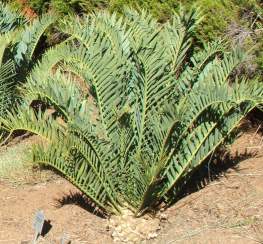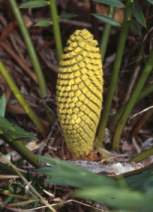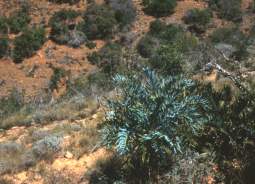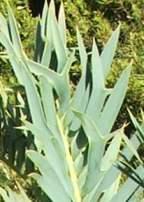Encephalartos trispinosus
Encephalartos trispinosus (Hook.) R.A.Dyer
Family: Zamiaceae
Common names: Bushman`s River cycad
SA Tree No: 14.18
Introduction
Encephalartos trispinosus is an excellent garden subject in hot, dry climates and areas which experience frost. The plants do not require a great deal of water once established. Sunny situations, rockeries and desert gardens are ideal situations for this species.

Description
Description
Encephalartos trispinosus developes stems up to 1 x 0.25-0.3 m, which are branched from the base and not necessarily upright, tending to lean over. A mature plant can develop 4 to 6 stems, with a number of suckers emerging at the base of the plant. The leaves, generally grey in colour, vary in size and shade of grey, depending on which population they originate from; they are 0.75-1.25 m long, and are recurved and twist towards the tip. The leaflets consist of 3 lobes with a spine borne at each point.

The cones of this species are bright yellow. One male cone is produced per stem, occasionally two. The cones are 250-350 x 70-80 mm. Female plants produce only one cone per stem and the cones are 400-500 x 180-200 mm . The scales are deeply wrinkled. The colour of the seeds ranges from pale red to orange. The cones emerge in midsummer (January-December in South Africa ). Male cones are harvested in the autumn (April) and pollination of the female cones takes place in April-May.
Distribution and habitat
Distribution description
Encephalartos trispinosus is endemic to South Africa and occurs in the valleys of the Bushman`s and Great Fish Rivers in the districts of Bathurst, Alexandria and Albany of the Eastern Cape. The species is fairly common. The plants grow amongst rocks in full sun and also in shady situations with scrub vegetation. The climate is hot in summer and cold in winter with regular frost. The rainfall varies between 600-725 mm a year which occurs mainly in the summer.

Derivation of name and historical aspects
History
The specfic name trispinosus refers to the three-spined lobes of the leaflets. This species was considered to be a variant of Encephalartos horridus or E. lehmannii until Dr R.A. Dyer reclassified it in 1965.

Ecology
Ecology
Not a great deal is known about the pollination of cycads. It is assumed that they are wind-pollinated but at the time of pollen-dispersal there is much insect activity, so insects could also be responsible for pollination.
Uses
Use
The living collection of E. trispinosus at Kirstenbosch is used for education, display and conservation by making seed and young plants available to botanic gardens and cycad enthusiasts.

Growing Encephalartos trispinosus
Grow
E. trispinosus is one of the slower-growing cycad species but does well in cultivation and will live to a great age provided it is positioned in a sunny situation which is well-drained. It can be used as an accent plant in rockeries, lawns and as a container plant. Ideal companion plants are low-growing aloes such as Aloe arborescens, Carpobrotus and Arctotis.
This species is not tall-growing, suckers freely and forms large, attractive, grey-leaved clumps. It is hardy, withstands frost and does not require a great deal of water.
Propagation of Encephalartos trispinosus can be achieved by sowing seed or by removing well-matured suckers from the mother plant. To produce true-to-type seed it is necessary to hand-pollinate the female cone with pollen harvested from a male cone of the same species. Germination ranges from 30-40%, on average. The seed is sown in spring on a bed of clean coarse sand which has bottom heat of 25-28º C. Within two months the seed germinates, producing a radicle followed by the leaves and 10 months later the seedlings are large enough to be removed and potted into 3-litre plastic sleeves, using a well-drained growing medium. The seedlings are watered sparingly until established.
Propagation by division involves removing well-developed suckers of approximately 250 mm in diameter from the mother plant. Early spring is an ideal time, when all leaves are removed from the sucker which is then carefully pulled away from the main stem. The sucker needs to be left for two weeks so that the wound can dry before planting in clean sand to encourage root development. Once well-rooted, the sucker can be planted out in the open ground.
Cycads require regular feeding. A thick layer of well-matured compost spread around the plant in autumn improves the condition of the soil and benefits the plants. An annual application of a well-balanced mixture of fertilizers applied in the spring is essential to maintain healthy cycads. A balanced inorganic fertilizer mixed with bonemeal and an organic fertilizer added is ideal.
The main pests which you may encounter when growing cycads are scale, mealy bugs and snout beetle. The scale and mealy bugs occur on the underside of the leaves and can be eliminated by applying a systemic insecticide. The snout beetles, which destroy the seeds, are nocturnal and can be eliminated by applying a contact insecticide.
New leaves, as they emerge, can also be damaged by a tiny mite. To prevent this damage, spray the new emerging leaves with a contact insecticide every two weeks. Regular spraying while new leaves are emerging will eventually eliminate the mite.
References
- Giddy, C. 1978. Cycads of South Africa. Purnell, Cape Town .
- Goode, D.1989. Cycads of Africa. Struik. Cape Town .
- Jones, D.L. 2002. Cycads of the world. Smithsonian Institution Press.
Credits
John Winter
Kirstenbosch NBG
May 2006
Plant Attributes:
Plant Type: Shrub, Tree
SA Distribution: Eastern Cape
Soil type:
Flowering season:
PH:
Flower colour:
Aspect: Full Sun
Gardening skill: Average
Special Features:
Horticultural zones











Rate this article
Article well written and informative
Rate this plant
Is this an interesting plant?
Login to add your Comment
Back to topNot registered yet? Click here to register.